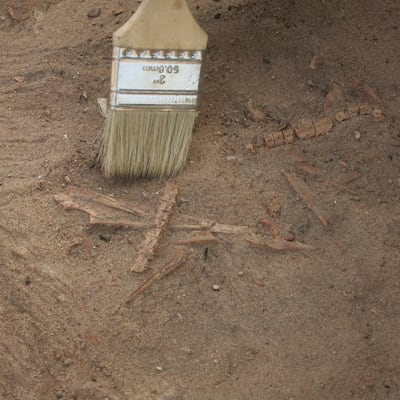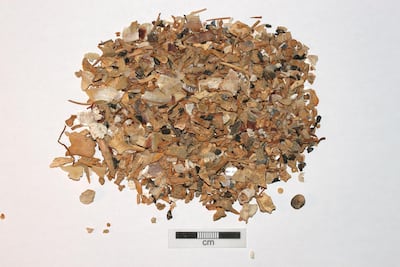Ancient fish bones are helping to shed light on how Stone Age communities thrived in the Arabian Gulf about 8,000 years ago.
Analysis of thousands of fragments recovered from two islands off the UAE revealed clues about the diets, fishing methods and lifestyles of some of the first documented civilisations in the region.
A large quantity of remains from small fish found close to the shore of Marawah Island suggests those who lived there used nets and coastal barrier traps to catch emperor fish and sea bream in the shallows.
Other bones offered evidence that some Stone Age groups in the area were not nomadic, as some experts believed, but settled in one location.
Mark Beech, head of archaeology for Al Dhafra and Abu Dhabi at the Department of Culture and Tourism, said the bones, which were recovered from ancient rubbish dumps at the sites, helped to draw a better picture of how people lived thousands of years ago.
"These rubbish dumps of food are a paradise for archaeologists because it gives us information about what the inhabitants were eating. We can get really detailed information from the fish bones," said Mr Beech, who helped carry out the research.
"We talk about the Neolithic revolution, when people elsewhere domesticated animals and plants, but in the Gulf region it's a different kind of revolution, because of the reliance on marine resources.
“They were eating everything that moves in the sea, catching shellfish, dolphins, dugongs, and doing lots of fishing.
"So the story with the fish bones is part of a bigger picture of these late Stone Age coastal communities, which adapted to their surroundings in the best way to survive."
The fish bones were recovered from the historic sites by sieving sediment.
On Marawah Island, which lies off the coast of Mirfa, a town about 170 kilometres west of the capital, the remains of stone houses were found. They are the earliest examples of such architecture in the Arabian Gulf.
Last week, archaeologists on the island also announced the discovery of what is believed to be the world’s oldest natural pearl. The gemstone dates between 5,800 and 5,600BC and proves pearls were used in the area about 8,000 years ago.
More than 7,500 fish bones were recovered from an area on the island that was once a stone house.
A further 54,846 bones were retrieved and recorded on Dalma Island, which is north-west of Sir Bani Yas Island.
On Marawah, 37 per cent of the recovered bones were preserved well enough to identify the family or species of fish the bones came from. On Dalma, it was 31 per cent.
The presence of stone sinkers at the sites – weights used to keep fishing nets in place – proves that a form of net was used to catch fish. Archaeologists believe traps, similar to gargoors, may have been made from date palm stems.
"Maybe 60 per cent of the bones are impossible to identify. But 30 or 40 per cent is still quite a lot," said Kevin Lidour, a researcher at Paris Sorbonne University.
By identifying the types of fish caught, archaeologists obtained information about the communities' diets and their hunting methods.

On Marawah, most of the fish were small grunts, sea bream or emperors, common in shallow waters.
Although some sharks and sawfish remains were found, the size of the bones were small, suggesting they were also caught inshore.
On Dalma, where surrounding waters are deeper, there was far more evidence of tuna, large groupers, sharks and dolphins.
That suggests fishermen used boats, nets and baited traps to catch fish in open water
.
Fish were the main part of communities' diets, although the remains of sheep, goats and cattle were also recovered at the sites.
The animals must have been introduced from other areas of the region, proving that trade took place with communities across the Gulf, including what is now Iraq.
About eight per cent of the fish bones studied from Dalma were burnt. Fire marks on parts of the skeleton that would have been less fleshy indicate the fish were probably cooked whole on coals.
The fish bones have also provided clues about whether the early inhabitants of the UAE lived as nomads.
It was believed the groups were nomadic, but the bones have added to a growing body of evidence that villages were occupied year-round by at least some of the community.
The presence of tuna in Dalma, which were more common in winter, and groupers, which were more common in spring and summer, suggest that fishing took place throughout the year.
"Many archaeologists who were working in the UAE and Oman thought that people from the Neolithic era were nomadic, because of comparisons with the Bedouin way of life," Mr Lidour said.



